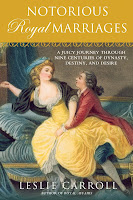NOTORIOUS ROYAL MARRIAGES

I can't believe that my thirteenth book releases today!
NOTORIOUS ROYAL MARRIAGES, A Juicy Journey Through Nine Centuries of Dynasty, Destiny, and Desire is my second foray into the world of historical nonfiction (my debut was back in June 2008 with ROYAL AFFAIRS, A Lusty Romp Through the Extramarital Adventures That Rocked the British Monarchy.)
Here's a sneak preview ... from the book's forward:
Everyone loves a royal wedding. Except, perhaps, the bride and groom. Throughout history, most royal marriages were arranged affairs, brokered for diplomatic and dynastic reasons, and often when the prospective spouses were mere children. The perfect royal marriage brought territorial gains to the ruling dynasty's side (usually the groom's) and cemented alliances between families and regions. It was of little consequence that the spouses often didn't meet until their wedding day. Or that they had been in love with someone else and were now compelled to abandon all hope of the personal happiness or emotional fulfillment that might have come from nuptial bliss with another. There is no I in dynasty.
In general, there was always one primary goal of a royal marriage: to beget an heir. And for a good part of the past millennium, when much of Western Europe was embroiled in perpetual warfare, it was believed that only a male heir would be able to defend and hold the throne, although a female could legally inherit the throne in England and Scotland. During more martial eras, royal wives who managed to produce only daughters-Katherine of Aragon and Anne Boleyn, for example-were disposed of by their spouse, powerless to challenge his authority. If execution was no longer an option to ending a problematic or infertile marriage, there was always divorce. Napoleon Bonaparte divorced his first wife, Josephine Beauharnais, because she failed to bear him a son.
With so many marriages being little more than dynastic alliances, how did these royals manage to survive their arranged nuptials and make their peace with the world into which they were born? Or did they? Precious few of the notorious royal marriages profiled in this book began as love matches—although they didn't necessarily stay that way. For several centuries, if things weren't working out, the monarch might play the all-purpose, get-out-of marriage-free card known as a papal dispensation on the grounds of consanguinity. In other words, plenty of unions were sundered after cousins who had received a dispensation to marry in the first place suddenly decided to become appalled and repulsed by how closely they were related when it became expedient to wed another.
With so many intriguing relationships, choosing whose stories to omit was nearly as difficult as selecting which ones to include. Within this volume are some of the world's most famous royal unions, as they affected and were affected by the historical and political events of the times; it is not intended to provide an overview of world history, to probe with great depth the wars and revolutions that gripped Europe for centuries, or to present a full biography of the principals.
Comparing the selection of a marriage partner to fishing for an eel—that staple of Renaissance diets-Sir Thomas More's father commented that it was as if "ye should put your hand into a blind bag full of snakes and eels together, seven snakes for one eel."
In these pages are the snakes as well as the eels—the disastrous unions and the delightful ones; the martyrs to marriage and the iconoclasts who barely took their vows seriously; the saintly and the suffering; the rebels, and the renegades-all of whom took the phrases "I do" and "I will" and ran as far as they could go with them, exploring and embracing the broad spectrum of passion, power, and possibilities far beyond the royal bedchamber.
Who is your favorite royal couple ... and why?


Comments
Post a Comment